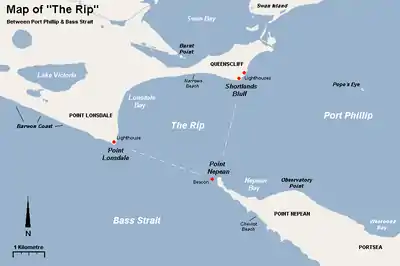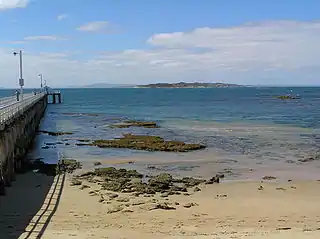The Rip
"The Rip", also known as "The Heads", is the narrow waterway entrance connecting the Bass Strait to the bay of Port Phillip in southern Victoria, Australia, and is the only route of maritime transport into Port Phillip and thus seaport access into Melbourne and Geelong, Victoria's two largest cities. Because of large tidal flows through the relatively narrow channel from the bay to the ocean, and a high rocky seabed, The Rip is a dangerous stretch of water and has claimed many ships and lives. Geographically, it is the roughly triangular area of water between the land points of Point Nepean on the Mornington Peninsula, Shortlands Bluff and Point Lonsdale on the Bellarine Peninsula, with these three forming The Heads.

Geography
The Rip is generally considered to be located in the triangular area of water between the land points of Point Nepean, Shortlands Bluff and Point Lonsdale. The entrance between Point Lonsdale and Point Nepean is 3.5 km wide but the reefs projecting from these points reduce the navigable width to about 1 km. Within 800m outside the Heads, there is a shallow rocky flat known as the Rip Bank. The water deepens outside this flat to 30m and inside the Heads to as much as 90 m. This inequality of depth combined with tidal streams running up to 6 knots, causes the world-renowned dangerous conditions. The variation in seafloor depth within the rip itself can be anywhere from 100m to less than 5m amongst the rocky reefs and shoals.

Navigation
The area of The Rip is a navigation hazard for recreational and small commercial vessels, due to strong tidal movements, unpredictable waves and proximity to active shipping lanes. Vessels are also prohibited from landing at Point Nepean on the southern central border of The Rip.[1]
Control of shipping movements through the heads is managed by the Point Lonsdale Signal Station. Large ships may only enter Port Phillip with a qualified pilot aboard to help them navigate through the heads.[2] The heads are very narrow, having a width of approximately two kilometres. When entering, large ships have to follow a precise S-shaped course through the heads. The Queenscliff Low Light ("white lighthouse") and Queenscliff High Light ("black lighthouse") form a leading line to guide ships through the main channel, in conjunction with the Hume and Murray Towers that show red and green lights respectively.
Vehicular crossings
At present, there are no bridges or tunnels that allow for vehicular traffic to cross the bay. Searoad Ferries operates a vehicular ferry service across the mouth of the bay between Queenscliff and Sorrento using two roll-on roll-off vessels.
Various bridge and tunnel projects have been proposed to link the heads of Port Phillip Bay, but none, so far, have gotten beyond the proposal stage. In an opinion piece published in the Herald Sun in 2018, Peter Mitchell asserted that no project would be approved in the near future because homes would have to be compulsorily acquired on both sides of the crossing, and no politician would be "prepared to bite that bullet."[3]
Swim crossing
Douglas Mew was the first person to swim across the Rip, on 13 June 1971. He completed the swim without a cage, in a time of 61 minutes. This achievement is commemorated by a plaque on the Point Lonsdale side of "The Rip".[4] The date of the first double crossing of the Rip is not recorded. A group of swimmers from the Brighton Icebergers did this double crossing. The first triple rip crossing occurred on 11 February 2017. Grant Cameron, Fran Johnson and Esther McDonald took 5 hours and 45 minutes (moving time) to complete the crossing. Flows at the heads (tides) had a significant effect on the swim that commenced at Point Lonsdale and ended on Point Nepean. While the crossing of "The Rip" as a swimmer has often been frowned upon by authorities and labelled foolhardy and reckless, the body of water can now be swum safely under the guidance of The Rip Swim organisation (www.ripswim.com.au). This project commenced in 2014 and after 6 years, has taken 472 swimmers across safely. The total number of swimmers officially recorded now stands at 518 as there were several groups of swimmers (predominantly from the Brighton Icebergers) who made the crossing around the late 90's and after the year 2000. There have also been 2 races across "The Rip" - organised by The Rip Swim organisation. The first one was in 2015 and Sam Sheppard and Naantali Marshall were the winners. The next race, which took place in 2018 was the single biggest crossing of "The Rip" so far. On that day 142 swimmers crossed in what was a combination of racing and group swimming. The Rip Swim organisation now focusses their efforts on taking small groups across, each accompanied by a kayaker and boats to ensure their safety.
References
- "Guide to Port Phillip" (PDF). Parks Victoria. 2012. Retrieved 22 September 2013.
- History, Port Phillip Sea Pilots, retrieved 22 October 2011
- Mitchell, Peter (9 April 2018). "Peter Mitchell says tunnel linking Mornington Peninsula to Bellarine unlikely". Herald Sun. Retrieved 27 November 2018.
- Design, UBC Web. "Douglas Mew | Monument Australia". monumentaustralia.org.au. Retrieved 7 February 2017.